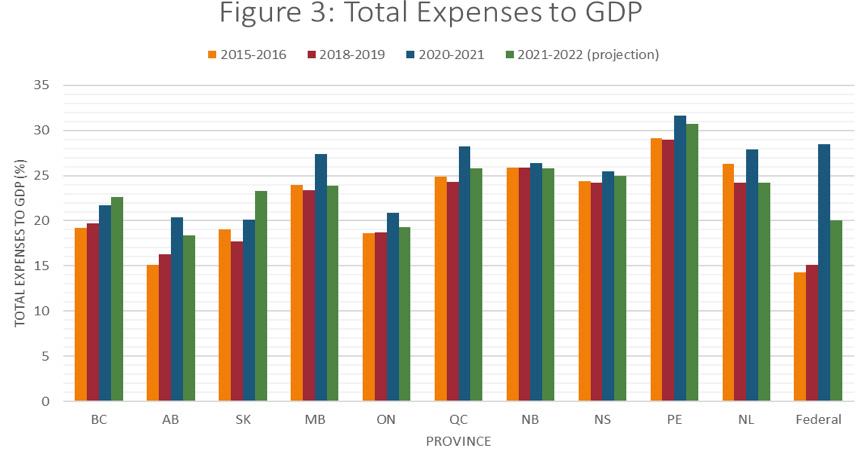
9 minute read
Student Essay Winner - Undergraduate
A SMITHIAN VIEW OF COVID-19 AND CANADA’S PUBLIC DEBT
ALLISON KNEE
An issue of great socioeconomic significance today is Canada’s public debt, both provincial and federal. Canadian federal debt has ballooned to over $1.1 trillion during the course of the ongoing COVID-19 pandemic (Statistics Canada, 2022). The purpose of this essay is to analyze whether this public debt is reasonable, or if it signals fiscal irresponsibility and a subsequent need for change. More specifically, this essay includes an application of the ideas of Adam Smith, the founding father of economics, to infer what he would have thought of how the government is currently handling Canada’s public debt situation, and how he might have suggested managing it differently (Smith, 1776/1904; Otteson, 2018).
Public debt is defined as the accumulated total of all government liabilities from raising funds to finance government expenditures through issuing bonds or other securities (Bird and Smart, 2006). Fiscal deficits are the yearly imbalances between government spending and revenues; if spending exceeds revenue, a budget deficit exists, which is added to existing public debt. Adam Smith, famous for his belief in a free and fair market system with little government intervention, included a chapter regarding public debts in his 1776 classic, The Wealth of Nations. In this chapter, Smith discussed the prevalence of public debt in European nations, specifically its distribution and its apparent effects in those nations. Consistent with his stance on government intervention in markets, Smith disapproved of too much outstanding public debt, because an overaccumulation of public debt would have negative consequences for economies, such as bankruptcy, among others (Smith, 1776/1904: 415). Smith further argued that at a certain point taxes become difficult to increase and are met with opposition by taxpayers; he discussed the concept of a “sinking fund” for paying off debt, but showed that such a fund was mostly misapplied to other expenses as a way to avoid raising taxes further:
When a nation is already overburdened with taxes, nothing but the necessities of a new war, nothing but either the animosity of national vengeance, or the anxiety for national security, can induce the people to submit, with tolerable patience, to a new tax. Hence the usual misapplication of the sinking fund. (Smith, 1776/1904: 406)
Smith’s ideas remain relevant in Canada today as government debt and tax rates are high, both historically and internationally. For instance, Canada’s total tax revenue soared from 25 percent of its GDP in 1965 to 34.4 percent of GDP in 2020, higher than the OECD average of 33.5 percent for the same year (OECD, 2021a). Similarly, Canada’s general government gross debt rose considerably from 70.6 percent in 2007 to 92.7 percent in 2019, compared with the 2019 OECD average of 79.9 percent (OECD, 2021b). Despite these trends, some governments today still view deficits as generally acceptable, and therefore use available funds—government income and tax revenues—for other purposes, for example fiscal stimulus or porkbarrel projects, that could otherwise be allocated to lessening the national debt. In contrast, Smith argued that the accumulation of public debt is inherently undesirable and paying off this accumulation is of utmost importance, as evidenced by his assurances that funds put aside for servicing this debt should not be used for other purposes. Some governments
Source: Statistics Canada Table 10-10-0002-01.
today still maintain sinking funds for the repayment of public debt (one of which is Newfoundland & Labrador), and for those governments that typically do not have sinking funds for servicing debt, Smith’s ideas mean that their budget surpluses, whenever available, should be earmarked for the repayment of debt. Smith emphasized the importance of reducing outstanding public debt this way: government spending increased in order to fund emergency support measures, such as the Canada Emergency Response Benefit (CERB), on which $74.08 billion was spent alone (Canada, 2022). This increase in spending combined with the pandemic’s adverse effects on business revenues had the effect of increasing federal debt from $697 billion in 2019, to $974 billion in 2020, and to $1,117 billion in 2021 (Statistics Canada, 2022). As Figure 1 shows, there was a noticeably large spike in the Canadian federal debt corresponding to the respective years of the pandemic’s influence. An important and pressing issue is how and if this spike can be reduced over time as the debt is ultimately paid off.
The more the public debts may have been accumulated, the more necessary it may have become to study to reduce them, the more dangerous, the more ruinous it may be to misapply any part of the sinking fund; the less likely is the public debt to be reduced to any considerable degree, the more likely, the more certainly is the sinking fund to be misapplied towards defraying all extraordinary expenses which occur in time of peace. (Smith, 1776: 406).
Today, Canada’s accumulated federal debt is estimated at $1.1 trillion, in addition to further projected annual government deficits, which contradict the concept of lessening this debt and maintaining a balanced budget (Statistics Canada, 2022). During the global COVID-19 pandemic, It is important to note that debt accumulation is a pressing issue not only at the federal level, but also at the provincial level across Canada. Debt-to-GDP ratios are commonly used to show the depth and significance of outstanding public debt relative to the national income of an economy; high debt-toGDP ratios signify a heavier debt burden on citizens and taxpayers. Figure 2 shows that the pandemic had the effect of raising net debt relative to GDP in all 10 provinces, thus raising future debt burdens to varying degrees. This effect was more pronounced in provinces where structural deficits existed prior to

Source: RBC Economics, Canadian federal and provincial data tables.
Source: RBC Economics, Canadian federal and provincial data tables.

the pandemic’s influence: Alberta, Newfoundland & Labrador, and Ontario in particular (Thanabalasingam and Abdelrahman, 2021).
Adam Smith’s overall negative view of national debt is echoed by many recent studies that warn of the undesirable consequences of growing government debt, including a correlation with negative economic growth, increases in interest rates over the long-term, and decreases in private investment, which challenge the ability of a country to sustain economic productivity (Fuss and Palacios, 2020; Fuss and Lafleur, 2021). These studies have also explained how tax increases have the effect of limiting economic growth. Perhaps the most relevant to Smith’s stance is the point that the more tax revenues are directed towards paying the interest on public debt, the less funding will be available for government social programs such as education, social services, and health care, let alone the possibility of tax cuts (Fuss and Palacios, 2020). As discussed above, Smith was of the opinion that paying off government debt and lowering interest costs was of critical importance, and not to be ignored in favour of other ways to spend money; in reality, there are political pressures on governments, especially during times of crisis such as the recent pandemic, to provide programs and services via debt financing that are unaffordable and unsustainable in the long run.
From the above analysis, it is clear that Adam Smith would have been an advocate for a very different approach to economic policy from the one currently adopted in Canada. According to Smith in The Wealth of Nations, the three duties of the government include: (1) protection of people from foreign invasion, (2) protection from injustice and oppression from within, and (3) creating and maintaining certain public works and certain institutions, which can never be ones that the private sector would erect and maintain (Smith, 1776; Otteson, 2018). Given the necessity of funding public goods such as health care and other services to protect Canadians from the COVID-19 virus, it is possible that Smith would have viewed a significant portion of the spending that resulted from the pandemic as justifiable. Nevertheless, there should be a more structured plan in place to ensure that the resulting debt is, and will be, financed properly. These necessary fiscal changes may come in the form of spending cuts, tax increases, new taxes, or a combination thereof, whichever is deemed appropriate. Prior to the COVID-19 pandemic, government spending was already arguably too high, as reflected by the high ratios of government expenditure to GDP shown in Figure 3 and also signified by the consistently large budget deficits that have persisted for years. While the global pandemic was admittedly unpredictable, not having balanced budgets prior to the pandemic meant that the governments had less fiscal resources to serve as a financial safety net (akin to Smith’s idea of a sinking fund) to aid in preventing the national debt from climbing to a record high level.
The impact of COVID-19 on the Canadian economy will last for many years to come. Managing this adverse impact is crucial for our country’s way forward. Canada should take Adam Smith’s advice and seek to follow the fiscally prudent tradition influenced by David Hume and Baron de Montesquieu: avoid large national debts when possible, and repay them promptly when they are incurred. In line with this concept, it is high time that the federal and provincial governments implemented more structured economic recovery plans to decrease government debt as the COVID-19 pandemic begins to subside in Canada.
Allison Knee is currently an undergraduate economics and business student at Memorial University of Newfoundland and Labrador. Her interests focus on the influence of politics, law, and business on the economy, as well as Canadian finance. After undergrad, she hopes to further her education in both law and business.
Acknowledgements

I would like to thank my professor, Dr. Kam Hon Chu for his encouragement, advice, and suggestions at various stages of writing this essay. All errors are, however, mine.
REFERENCES
Bird, R.M. and M. Smart (2006/2015). Public Debt. The Canadian Encyclopedia. <https://www.thecanadianencyclopedia.ca/en/article/public-debt>, as of August 23, 2022. Canada (2022). Canada Emergency Response Benefit and EI statistics. Government of Canada. <https://www.canada.ca/en/services/benefits/ei/claims-report.html>, as of May 30, 2022. Fuss, Jake, and Steve Lafleur (2021). The Growing Debt Burden for Canadians: 2021 edition. Fraser Institute. <https://www.fraserinstitute.org/studies/growing-debt-burden-forcanadians-2021>, as of August 23, 2022. Fuss, Jake, and Milagros Palacios (2020). The Growing Debt Burden for Canadians. Fraser Institute. <https://www.fraserinstitute.org/studies/growing-debt-burden-for-canadians>, as of August 23, 2022. Organisation for Economic Co-operation and Development [OECD] (2021a). Revenue Statistics - OECD Countries: Comparative Tables. OECD. <https://stats.oecd.org/index. aspx?DataSetCode=rev#>, as of August 16, 2022. Organisation for Economic Co-operation and Development [OECD] (2021b). Government at a Glance -2021 Edition. OECD. <https://stats.oecd.org/Index. aspx?DataSetCode=GOV_2021>, as of August 16, 2022. Otteson, James (2018). The Essential Adam Smith. Fraser Institute. <https://www.essentialscholars.org/smith>, as of August 23, 2022. RBC Economics (2022). Canadian Federal and Provincial Fiscal Tables. RBC Economics. <http://www.rbc.com/economics/economic-reports/pdf/canadian-fiscal/prov_fiscal.pdf>, as of June 14, 2022. Smith, Adam. (1776/1904). An Inquiry into the Nature and Causes of the Wealth of Nations. Fifth edition. Methuen. Statistics Canada (2022). Table 10-10-0002-01: Central Government Debt (x 1,000,000). Custom search. Statistics Canada. <https://www150.statcan.gc.ca/ t1/tbl1/en/tv.action?pid=1010000201&cubeTimeFrame.startMonth=01&cubeTimeFrame.startYear=2015&cubeTimeFrame.endMonth=03&cubeTimeFrame. endYear=2022&referencePeriods=20150101%2C20220301>, as of May 14, 2022. Thanabalasingam, Sri, and Omar Abdelrahman (2021). Fiscal Stimulus and Elevated Debt: A New Chapter for the Canadian Economy. TD Economics. <https://economics.td.com/fiscalstimulus-debt>, as of August 23, 2022.

